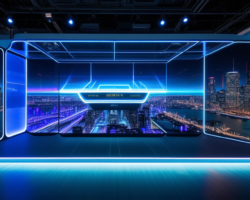In a world where technology evolves at lightning speed, it’s easy to overlook the hidden innovations that are quietly reshaping our lives. These advancements, often flying under the radar, are not just buzzwords; they are the very foundation of the next tech boom that promises to revolutionise industries and enhance our everyday experiences. Imagine a future where artificial intelligence seamlessly integrates into our daily routines, making tasks easier and more efficient. Think about how blockchain technology could transform everything from supply chains to personal identity verification, ensuring transparency and security like never before.
As we delve deeper, we’ll uncover the layers of these innovations that are set to redefine our economy and society. For instance, how many of us are aware that Augmented Reality (AR) is not just for gaming? It’s being harnessed in classrooms to create interactive learning environments that captivate students’ attention. Similarly, Virtual Reality (VR) is not only about entertainment; it’s paving the way for realistic training simulations in critical fields like healthcare and aviation.
So, are you ready to explore these hidden gems of technology? Buckle up, because the journey into the future of innovation is just beginning!
Artificial Intelligence in Everyday Applications
Artificial Intelligence (AI) is not just a buzzword; it’s a game-changer that’s infiltrating our daily lives in ways we often overlook. From the moment you wake up and ask your smart speaker about the weather to the time you order your groceries online, AI is silently working behind the scenes. Have you ever wondered how Netflix seems to know exactly what you want to watch next? That’s AI analysing your viewing habits and preferences to make personalised recommendations.
This technology is revolutionising industries, particularly in healthcare and finance. Imagine a world where AI can predict health issues before they become critical. For instance, AI algorithms can analyse medical data to identify patterns, leading to early diagnosis of diseases. In finance, AI is streamlining processes by automating routine tasks such as fraud detection and risk assessment, allowing professionals to focus on more complex decision-making.
Moreover, AI enhances productivity in the workplace. With tools like virtual assistants and chatbots, businesses can improve customer service while freeing up human resources for more strategic tasks. The possibilities are endless, and as AI continues to evolve, it’s set to redefine how we interact with technology and each other.
In summary, AI is not just about robots or futuristic concepts; it’s about enhancing our everyday experiences. As we embrace these innovations, the future looks bright, promising a seamless integration of technology into our daily routines.
Blockchain Beyond Cryptocurrency
When you hear the term blockchain, your mind might instantly jump to cryptocurrencies like Bitcoin or Ethereum. However, the truth is that blockchain technology is much more than just a digital currency platform. It’s a revolutionary tool that’s reshaping various industries and enhancing everyday operations. Imagine a world where transactions are transparent, secure, and efficient—that’s the promise of blockchain.
One of the most exciting applications of blockchain is in supply chain management. By leveraging this technology, companies can track products from their origin to the end consumer in real-time. This not only increases accountability but also helps in identifying inefficiencies and reducing fraud. For instance, a table below illustrates how blockchain can improve transparency across different stages of the supply chain:
| Stage | Traditional Process | Blockchain Process |
|---|---|---|
| Manufacturing | Manual records | Real-time updates |
| Shipping | Paper-based tracking | Digital tracking |
| Retail | Limited visibility | Full transparency |
Additionally, blockchain is making waves in the realm of digital identity verification. With the rise of online transactions, ensuring the authenticity of identities has become crucial. Blockchain provides a secure way to manage personal data, reducing the risk of fraud and identity theft. By enabling users to control their own identities, it enhances privacy and security in the digital landscape.
In summary, blockchain is not just a buzzword associated with cryptocurrencies; it is a transformative technology with the potential to revolutionise industries, enhance transparency, and improve security. As we continue to explore its applications, the possibilities seem endless.
Smart Contracts: Automating Agreements
Smart contracts are revolutionising the way we conduct agreements by automating the entire process through code. Imagine a world where you don’t need to rely on intermediaries like lawyers or notaries to enforce contracts; that’s the power of smart contracts! These self-executing contracts have the terms of the agreement directly written into the code, allowing for trustless transactions that are both efficient and secure.
One of the most exciting aspects of smart contracts is their ability to operate on blockchain technology, which ensures that once the contract is executed, the results are immutable and transparent. This means that all parties involved can verify the outcome without the need for a third party. For instance, in real estate transactions, smart contracts can automatically transfer ownership once payment is received, streamlining the entire process and reducing the risk of fraud.
Furthermore, smart contracts are not just limited to financial transactions. They can be applied across various industries, including:
- Insurance: Automating claims processing based on predefined conditions.
- Supply Chain: Ensuring that goods are delivered as per the contract terms.
- Entertainment: Distributing royalties automatically when content is consumed.
As we embrace this technology, the future looks promising. With smart contracts, we can expect a significant reduction in costs and time associated with traditional agreements, paving the way for a more efficient economy.
Decentralised Finance (DeFi) Solutions
Decentralised Finance, or DeFi, is nothing short of a financial revolution, shaking up the traditional banking system as we know it. Imagine a world where you can lend, borrow, and trade without the need for banks or intermediaries. Sounds like a dream, right? Well, that dream is becoming a reality! DeFi platforms leverage blockchain technology to create a transparent, accessible, and efficient financial ecosystem.
At its core, DeFi empowers users by providing direct access to financial services. This means you can manage your assets, earn interest, and even take out loans—all without the red tape typically associated with traditional finance. The beauty of DeFi lies in its trustless nature, which eliminates the need for a middleman. Instead, smart contracts handle transactions automatically, ensuring that all parties adhere to the agreed terms.
Here are some key features that make DeFi solutions stand out:
- Accessibility: Anyone with an internet connection can access DeFi platforms, breaking down barriers to entry.
- Transparency: All transactions are recorded on the blockchain, making them publicly verifiable.
- Interoperability: Many DeFi applications can work together, creating a seamless financial experience.
As we move forward, DeFi is set to redefine our understanding of finance, offering new opportunities for individuals and businesses alike. So, are you ready to dive into the world of decentralised finance and explore its limitless potential?
Supply Chain Transparency
The concept of is rapidly gaining traction in the business world, and for good reason. In an age where consumers are increasingly conscious about the origins of their products, companies are turning to blockchain technology to provide clarity and accountability throughout their supply chains. Imagine being able to trace the journey of your favourite coffee from the farm to your cup, all while ensuring fair practices were upheld at every step.
By leveraging blockchain, businesses can enable real-time tracking of goods, which not only enhances trust among stakeholders but also optimises operational efficiency. This transparency allows companies to identify bottlenecks, reduce waste, and ultimately deliver better products to consumers. Furthermore, with the integration of smart contracts, transactions can be executed automatically when conditions are met, further streamlining processes.
Consider the following benefits of enhanced supply chain transparency:
- Improved Accountability: Companies can hold suppliers accountable for their practices.
- Enhanced Consumer Trust: Customers are more likely to purchase from brands that demonstrate ethical sourcing.
- Risk Mitigation: Real-time data helps identify potential disruptions before they escalate.
In conclusion, as businesses continue to embrace these innovations, the future of supply chains looks not only more efficient but also more ethical. The ripple effects of this transparency will likely reshape consumer expectations and redefine industry standards.
Digital Identity Management
In today’s digital landscape, is becoming increasingly vital. With the rise of online interactions, protecting our identities has never been more crucial. Imagine your digital identity as a fortress; without proper management, it’s like leaving the gates wide open for intruders. The integration of blockchain technology offers a revolutionary approach to safeguarding personal information.
Blockchain enables a secure method of verifying identities, making it nearly impossible for fraudsters to manipulate data. This technology ensures that your information is not only protected but also easily accessible when needed. For instance, in the realm of online banking, customers can authenticate their identities without the fear of data breaches. This is a game changer!
Moreover, digital identity management can significantly enhance privacy. With traditional methods, personal details are often stored in centralised databases, making them prime targets for cyberattacks. However, with blockchain, your identity is decentralised, meaning it’s scattered across multiple nodes, thereby reducing vulnerability. This approach fosters trust and accountability in digital transactions.
In summary, as we navigate through the complexities of the digital age, embracing robust digital identity management systems will be essential. By leveraging blockchain technology, we can create a safer and more efficient online environment for everyone.
Augmented and Virtual Reality Transformations
Augmented Reality (AR) and Virtual Reality (VR) are not just buzzwords; they are transformative technologies that are reshaping our interaction with the digital world. Imagine walking through a museum where the paintings come to life, or being able to practice surgical procedures in a risk-free environment. These scenarios are becoming a reality, and they are fundamentally changing how we learn, work, and play.
In education, AR is enhancing learning experiences by creating interactive environments. Students can explore complex subjects like biology or physics through immersive simulations that make learning engaging and effective. For instance, a student studying the human anatomy can use AR to visualise organs in 3D, making it easier to grasp intricate details.
On the other hand, VR is making waves in training simulations across various sectors. It allows trainees to experience real-life scenarios without the associated risks. For example, in aviation, pilots can undergo flight simulations that mimic real-world challenges, preparing them for any situation they might face in the cockpit. This method not only boosts confidence but also enhances skill retention.
As these technologies continue to evolve, their potential applications are limitless. From gaming and entertainment to healthcare and education, AR and VR are set to create immersive experiences that will redefine our understanding of reality. The future is not just about viewing content; it’s about experiencing it in ways we never thought possible!
AR in Education
Augmented Reality (AR) is not just a buzzword; it’s a game changer in the realm of education. Imagine stepping into a classroom where the walls come alive with interactive lessons that leap off the page! AR technology creates a dynamic learning environment that captivates students’ attention and enhances their understanding of complex subjects.
For instance, in a history lesson, students can use AR to witness historical events as if they were right there in the moment. This immersive experience makes learning not only more enjoyable but also more effective. With AR, the traditional textbook transforms into a vivid learning tool, providing:
- Interactive Experiences: Students can manipulate 3D models, bringing abstract concepts to life.
- Enhanced Engagement: The excitement of AR keeps students motivated and eager to learn.
- Improved Knowledge Retention: Visual and interactive elements help solidify information in students’ minds.
Moreover, educators are finding that AR can cater to different learning styles. Visual learners thrive with interactive graphics, while kinesthetic learners benefit from hands-on activities. As AR technology continues to evolve, we can expect it to become a staple in classrooms, paving the way for a more inclusive and effective educational landscape.
VR for Training Simulations
Imagine stepping into a world where you can practice complex procedures without the fear of making a mistake. Virtual Reality (VR) is doing just that, revolutionising training simulations across various industries. From healthcare to aviation, VR is creating immersive environments that allow trainees to engage in lifelike scenarios. This technology enables users to experience situations they might encounter in real life, providing a safe space to learn and hone their skills.
For instance, in the healthcare sector, medical professionals can practice surgeries using VR simulations. This not only enhances their technical abilities but also boosts their confidence before they operate on real patients. Similarly, pilots can train in flight simulators that replicate the cockpit experience, allowing them to react to emergencies without any real-world consequences. The benefits of VR training are extensive:
- Enhanced Engagement: Trainees are more likely to stay focused and retain information when learning in an interactive environment.
- Cost-Effectiveness: Reduces the need for physical materials and resources, ultimately saving money in the long run.
- Immediate Feedback: Users receive instant evaluations, allowing them to improve their performance in real-time.
As industries continue to embrace VR technology, the potential for improved training outcomes is limitless. The future is here, and it’s immersive!
Frequently Asked Questions
- What are some everyday applications of Artificial Intelligence?
AI is making waves in our daily lives! From virtual assistants like Siri and Alexa to smart home devices that learn your habits, AI is everywhere. It helps in personalising your online shopping experience, enhancing customer service, and even optimising healthcare by predicting patient needs.
- How does blockchain technology extend beyond cryptocurrency?
Great question! While most people think of blockchain as just the backbone of Bitcoin, it’s actually revolutionising many industries. For instance, in supply chain management, it ensures transparency and traceability. In healthcare, it secures patient data and in digital identity verification, it protects against fraud.
- What are smart contracts and how do they work?
Smart contracts are like digital vending machines. You put in your money (or data), and they automatically execute the terms of your agreement without needing a middleman. This technology simplifies transactions, making them faster and more reliable.
- How is Augmented Reality used in education?
AR is transforming classrooms into interactive learning hubs! Imagine students exploring ancient ruins or the human body in 3D right from their desks. This immersive experience boosts engagement and helps with knowledge retention like never before.





